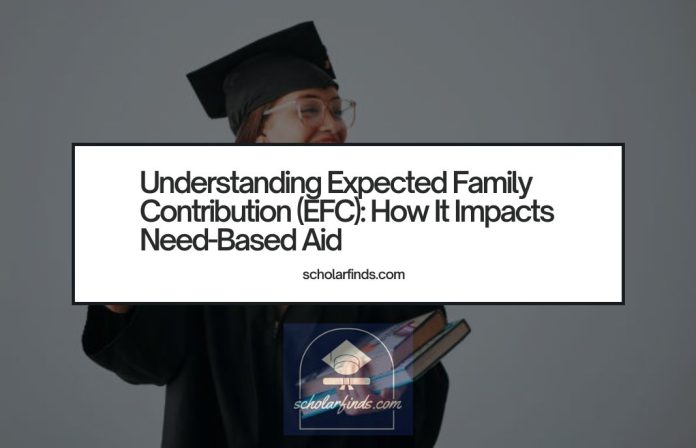Introduction
Understanding Expected Family Contribution (EFC): How It Impacts Need-Based Aid – Navigating the world of financial aid can be challenging, especially when it comes to understanding how your financial need is determined. A key component in this process is the Expected Family Contribution (EFC), a number that plays a crucial role in determining your eligibility for need-based aid, including scholarships and grants. In this guide, we’ll explain what the EFC is, how it’s calculated, and how it impacts the amount of financial aid you may receive.
What is the Expected Family Contribution (EFC)?
The Expected Family Contribution (EFC) is a number used by colleges and the federal government to estimate how much your family can afford to contribute toward your college education. It’s not the amount your family will actually pay, but rather a metric used to determine your financial need and, subsequently, your eligibility for need-based financial aid.
- EFC and Financial Aid: The lower your EFC, the more likely you are to qualify for need-based financial aid such as grants, scholarships, and subsidized loans.
- Federal and Institutional Use: Both the federal government and individual colleges use the EFC to allocate financial aid packages.
How is the EFC Calculated?
The EFC is calculated using a formula that takes into account your family’s financial situation, including income, assets, family size, and the number of family members currently attending college. The calculation process involves several factors:
- Income: Both your parents’ income and your own (if applicable) are considered. The formula generally assumes that a certain percentage of income can be contributed to college costs.
- Assets: This includes savings, investments, and other assets owned by your family, excluding certain types like retirement accounts.
- Family Size and Number of College Students: The formula adjusts for how many people are in your family and how many are currently enrolled in college, which can reduce your EFC.
- Special Circumstances: While the standard formula applies to most families, special circumstances like medical expenses or a recent job loss can be taken into account by financial aid offices.
The EFC is calculated after you submit the Free Application for Federal Student Aid (FAFSA). Once processed, you’ll receive your EFC on your Student Aid Report (SAR).
How EFC Impacts Financial Aid Eligibility
Your EFC directly influences how much need-based aid you are eligible to receive. Here’s how it works:
1. Determining Financial Need
Financial need is calculated by subtracting your EFC from the Cost of Attendance (COA) at a particular college. The COA includes tuition, fees, room and board, books, and other educational expenses.
- Formula:
Financial Need=Cost of Attendance (COA)−Expected Family Contribution (EFC)\text{Financial Need} = \text{Cost of Attendance (COA)} – \text{Expected Family Contribution (EFC)}
For example, if the COA at a college is $30,000 and your EFC is $5,000, your financial need would be $25,000. This need is the amount that may be covered by need-based financial aid, such as grants, scholarships, and work-study programs.
2. Eligibility for Need-Based Scholarships and Grants
The amount of need-based aid you receive is influenced by your financial need. A lower EFC increases your eligibility for more substantial aid packages.
- Federal Grants: Programs like the Pell Grant are awarded based on your EFC. If your EFC is below a certain threshold, you may qualify for the maximum grant amount.
- Institutional Aid: Many colleges use the EFC to determine their own need-based scholarships. Schools with generous aid policies may meet a large percentage of your financial need, reducing the out-of-pocket cost of attendance.
- State Aid: Some states also use your EFC to determine eligibility for state-funded grants and scholarships.
3. Gaps in Financial Aid
Even with need-based aid, there may still be a gap between your financial need and the aid you receive. Understanding your EFC can help you plan how to cover this gap, whether through additional scholarships, loans, or other financial resources.
Demystifying the EFC Calculation
The EFC formula can seem complex, but understanding the basics can help you better anticipate your financial aid eligibility. Here are a few key points:
- Parent Contribution: A percentage of your parents’ income and assets is expected to go toward your education.
- Student Contribution: If you have significant savings or income, a higher percentage of these resources may be expected to contribute to your college costs.
- Adjusted Gross Income (AGI): Your family’s AGI is a major factor in the calculation. Deductions and exemptions on your taxes can influence your EFC.
- Asset Protection: Certain assets are excluded from the EFC calculation, such as retirement funds and the value of the family home.
To get an estimate of your EFC before applying for aid, you can use the FAFSA4caster tool provided by the U.S. Department of Education. This can help you plan and prepare for the financial aid process.
Conclusion
The Expected Family Contribution (EFC) is a central factor in determining your eligibility for need-based financial aid. Understanding how it’s calculated and how it impacts your financial aid package can help you navigate the college financing process more effectively. While the EFC may seem intimidating at first, breaking down its components and implications allows you to better plan for your educational expenses and maximize the aid you receive. Remember, the EFC is a starting point—explore all available resources, including need-based scholarships, to fully fund your college education.



